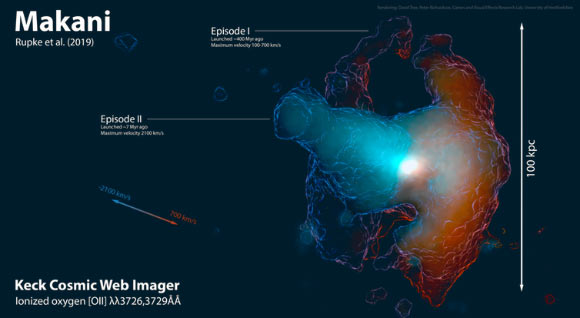Astronomers Observe Giant Outflow of Gas Extending Far Beyond Compact Galaxy | Astronomy – Sci-News.com
The direct evidence of the role of galactic winds — ejections of gas from galaxies — in creating the so-called circumgalactic medium has been discovered by a research team led by Rhodes College astronomer David Rupke.

A volume rendering of the ionized gas wind in the Makani galaxy. Two of the dimensions are spatial, and the third is velocity. The colors trace the velocity axis, shown by the arrow at center. The approximate locations of the two proposed outflow episodes are labeled. Image credit: Jim Geach, David Tree & Peter Richardson, University of Hertfordshire.
Dr. Rupke and colleagues spotted an ionized outflow spanning 261,000 by 326,000 square light-years from a galaxy called SDSS J211824.06+001729.4 (nicknamed Makani).
They analyzed data collected by the Keck Cosmic Web Imager instrument, the NASA/ESA Hubble Space Telescope and the Atacama Large Millimeter Array (ALMA).
The Keck data allowed the researchers to distinguish a fast gaseous outflow launched from the galaxy a few million years ago, from a gas outflow launched hundreds of millions of years earlier that has since slowed significantly.
“The earlier outflow has flowed to large distances from the galaxy, while the fast, recent outflow has not had time to do so,” Dr. Rupke said.
From the Hubble, the scientists procured images of Makani’s stars, showing it to be a massive, compact galaxy that resulted from a merger of two once separate galaxies.
From ALMA, they could see that the outflow contains molecules as well as atoms.
The datasets indicated that with a mixed population of old, middle-age and young stars, the galaxy might also contain a dust-obscured accreting supermassive black hole.
This suggests to the scientists that Makani’s properties and timescales are consistent with theoretical models of galactic winds.
“In terms of both their size and speed of travel, the two outflows are consistent with their creation by these past starburst events; they’re also consistent with theoretical models of how large and fast winds should be if created by starbursts,” said Dr. Alison Coil, an astronomer at the University of California, San Diego.
“So observations and theory are agreeing well here.”
The hourglass shape of Makani’s nebula is strongly reminiscent of similar galactic winds in other galaxies, but that Makani’s wind is much larger than in other observed galaxies.
“This means that we can confirm it’s actually moving gas from the galaxy into the circumgalactic regions around it, as well as sweeping up more gas from its surroundings as it moves out,” Dr. Rupke said.
“And it’s moving a lot of it — at least one to 10% of the visible mass of the entire galaxy — at very high speeds, thousands of miles per second.”
The findings were published in the journal Nature.
_____
David S.N. Rupke et al. 2019. A 100-kiloparsec wind feeding the circumgalactic medium of a massive compact galaxy. Nature 574: 643-646; doi: 10.1038/s41586-019-1686-1





